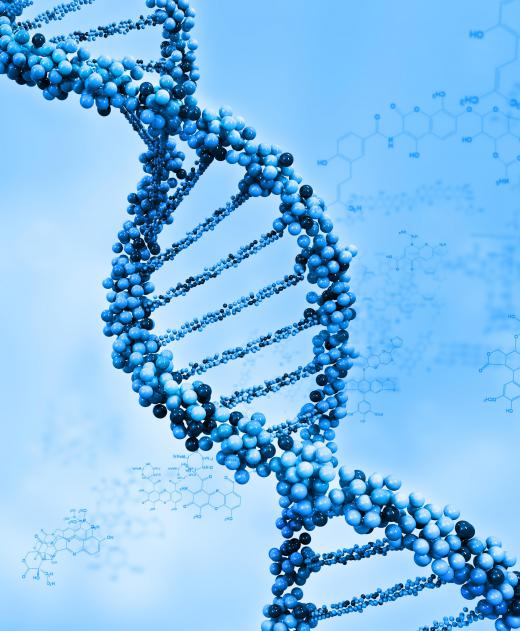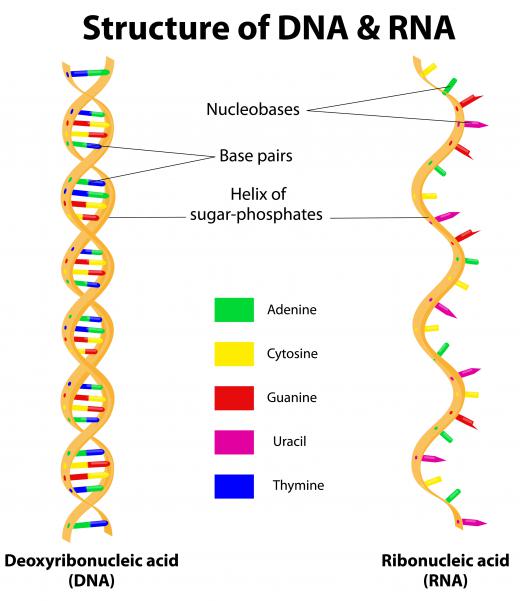What is a Stop Codon?
 Mary McMahon
Mary McMahon
A stop codon is a nucleic acid triplet in messenger RNA (mRNA) which does not code for an amino acid, thereby stopping the production of a protein. Essentially, the stop codon tells the ribosomes executing the mRNA code that it's time to stop; one could think of it almost as a perforated line in a sheet of paper indicating “tear here.” Without a stop codon in place, proteins made from RNA would consist of endless chains of amino acids, because the ribosomes would not know when to stop.
Stop codons are also present in DNA, so that they carry over when DNA is transcribed into RNA. In DNA, the three stop codons are TAA, TAG, and TGA. These triplets are “nonsense” codons which do not code for anything, reducing the risk that a mistake will be made. When transcribed into RNA, the stop codons are UAA, UAG, and UGA.

The length of an amino acid chain in a protein can vary, which means that stop codons are found at varying intervals in coding DNA and RNA, the areas of the genetic code which contain information which needs to be executed to make proteins. Stop codons can be identified when DNA is sequenced, and can be used to identify the specific locations in the genetic code which correspond to particular proteins, and thereby to particular genetic information.

As with other areas of DNA, it is possible for a mutation to appear in a stop codon. The codon may be transcribed incorrectly, or nucleic acids in the codon can be swapped out, causing problems when the ribosomes go to translate the mRNA to build amino acid chains. In a single cell, this can result in a random mutation which causes the cell to die or malfunction. If errors occur in the stop codons in a germ cell, however, and that germ cell joins with one from another organism, the resulting organism will have a congenital mutation, and in some cases, the mutation may be so severe that the organism cannot live.
Geneticists can use their knowledge of stop codons to sort out the information in a chunk of DNA or RNA. By looking for stop codons, they can identify specific chains of amino acids and determine which proteins the genetic material is coding for. This information can be used to learn more about what it does, and what happens when it goes wrong. Finding a stop codon can be useful when studying DNA and RNA to learn more about a mutation or variation which has been identified.
AS FEATURED ON:
AS FEATURED ON:












Discussion Comments
@Ana1234 - Actually, mutations of the stop codons don't always mean that the creature with them cannot survive. In fact, that's how they discovered the stop codons. They observed that viruses with particular mutations would act a certain way and so they could isolate the virues that had those mutations and study them in order to find out which sequence of genes produced the mutation.
It's quite interesting sometimes to see the roundabout ways that different scientific knowledge was discovered. The stop codons list was originally named after different colors of earthy yellow, because the original one was named Amber after the guy who discovered it.
@bythewell - Actually, genetic mutations like mistakes with the stop codons in DNA happen all the time. Most people don't realize it, but they estimate that a very high percentage of pregnancies end in miscarriage, they just happen so early that the woman doesn't even know she was pregnant. And those miscarriages often happen because of genetic mutations, which did not allow the baby to live. A mutation of the stop codon, for example, is almost never going to be helpful, as it makes quite a huge difference in the genes.
It seems like there is so much that can go wrong with DNA it's a wonder anything ever goes right. The stop codons are so important and they can so easily go wrong. I guess DNA isn't as delicate and finely balanced as it seems when you study it, however, since it rarely does go wrong. If it did, there wouldn't be so much life all around us, as, without every stop codon in each animal and plant working the way it's supposed it, they wouldn't be here.
Post your comments